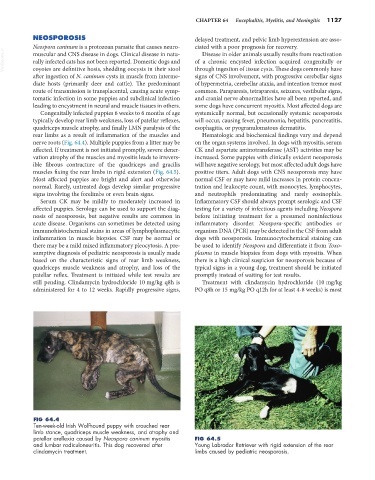Page 1155 - Small Animal Internal Medicine, 6th Edition
P. 1155
CHAPTER 64 Encephalitis, Myelitis, and Meningitis 1127
NEOSPOROSIS delayed treatment, and pelvic limb hyperextension are asso-
Neospora caninum is a protozoan parasite that causes neuro- ciated with a poor prognosis for recovery.
VetBooks.ir muscular and CNS disease in dogs. Clinical disease in natu- of a chronic encysted infection acquired congenitally or
Disease in older animals usually results from reactivation
rally infected cats has not been reported. Domestic dogs and
coyotes are definitive hosts, shedding oocysts in their stool
signs of CNS involvement, with progressive cerebellar signs
after ingestion of N. caninum cysts in muscle from interme- through ingestion of tissue cysts. These dogs commonly have
diate hosts (primarily deer and cattle). The predominant of hypermetria, cerebellar ataxia, and intention tremor most
route of transmission is transplacental, causing acute symp- common. Paraparesis, tetraparesis, seizures, vestibular signs,
tomatic infection in some puppies and subclinical infection and cranial nerve abnormalities have all been reported, and
leading to encystment in neural and muscle tissues in others. some dogs have concurrent myositis. Most affected dogs are
Congenitally infected puppies 6 weeks to 6 months of age systemically normal, but occasionally systemic neosporosis
typically develop rear limb weakness, loss of patellar reflexes, will occur, causing fever, pneumonia, hepatitis, pancreatitis,
quadriceps muscle atrophy, and finally LMN paralysis of the esophagitis, or pyogranulomatous dermatitis.
rear limbs as a result of inflammation of the muscles and Hematologic and biochemical findings vary and depend
nerve roots (Fig. 64.4). Multiple puppies from a litter may be on the organ systems involved. In dogs with myositis, serum
affected. If treatment is not initiated promptly, severe dener- CK and aspartate aminotransferase (AST) activities may be
vation atrophy of the muscles and myositis leads to irrevers- increased. Some puppies with clinically evident neosporosis
ible fibrous contracture of the quadriceps and gracilis will have negative serology, but most affected adult dogs have
muscles fixing the rear limbs in rigid extension (Fig. 64.5). positive titers. Adult dogs with CNS neosporosis may have
Most affected puppies are bright and alert and otherwise normal CSF or may have mild increases in protein concen-
normal. Rarely, untreated dogs develop similar progressive tration and leukocyte count, with monocytes, lymphocytes,
signs involving the forelimbs or even brain signs. and neutrophils predominating and rarely eosinophils.
Serum CK may be mildly to moderately increased in Inflammatory CSF should always prompt serologic and CSF
affected puppies. Serology can be used to support the diag- testing for a variety of infectious agents including Neospora
nosis of neosporosis, but negative results are common in before initiating treatment for a presumed noninfectious
acute disease. Organisms can sometimes be detected using inflammatory disorder. Neospora-specific antibodies or
immunohistochemical stains in areas of lymphoplasmacytic organism DNA (PCR) may be detected in the CSF from adult
inflammation in muscle biopsies. CSF may be normal or dogs with neosporosis. Immunocytochemical staining can
there may be a mild mixed inflammatory pleocytosis. A pre- be used to identify Neospora and differentiate it from Toxo-
sumptive diagnosis of pediatric neosporosis is usually made plasma in muscle biopsies from dogs with myositis. When
based on the characteristic signs of rear limb weakness, there is a high clinical suspicion for neosporosis because of
quadriceps muscle weakness and atrophy, and loss of the typical signs in a young dog, treatment should be initiated
patellar reflex. Treatment is initiated while test results are promptly instead of waiting for test results.
still pending. Clindamycin hydrochloride 10 mg/kg q8h is Treatment with clindamycin hydrochloride (10 mg/kg
administered for 4 to 12 weeks. Rapidly progressive signs, PO q8h or 15 mg/kg PO q12h for at least 4-8 weeks) is most
FIG 64.4
Ten-week-old Irish Wolfhound puppy with crouched rear
limb stance, quadriceps muscle weakness, and atrophy and
patellar areflexia caused by Neospora caninum myositis FIG 64.5
and lumbar radiculoneuritis. This dog recovered after Young Labrador Retriever with rigid extension of the rear
clindamycin treatment. limbs caused by pediatric neosporosis.

